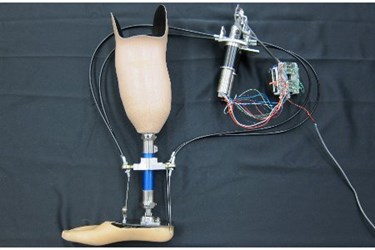Prosthetic Leg Can "See" Where It's Going

A team of engineers at Michigan Technological University announced plans to further develop its robotic ankle technology by adding an artificial vision system that could analyze visual information and adjust the user’s gait accordingly.
In 2013, Mo Rastgaar, an assistant professor of mechanical engineering at Michigan Tech, and Ph.D. student Evandro Ficanha introduced a prosthetic ankle and foot controlled by a microprocessor. Their goal was to design a prosthetic foot with a broader range of motion and complexity to mimic natural human gait.
According to Rastgaar, existing microprocessor-controlled prosthetics are capable of moving up and down, but his team wanted to incorporate a side-to-side roll, arguing that very few people can walk continuously in a straight line without encountering obstacles.
In its design, Rastgaar’s team relocated the control mechanism of the device up away from the leg to lighten the prosthesis, and used a cable-driven mechanism similar to a bicycle brake to allow the foot to move in almost any direction. Experiments conducted with the robotic ankle showed that it was able to walk both in a straight line and in a circle.
The team’s latest development with the device incorporates a visual system using a camera and a computer-controlled actuator. The engineers claim that the new prototype can adjust and adapt automatically to its surroundings by responding to external stimuli.
“The camera can identify the profile of the ground, while the computer knows where the next footstep will be, based on how the user is moving the leg. Then the computer analyzes the information from the camera and applies the correct angle and stiffness to the ankle, just as you would with your biological foot and ankle,” Rastgaar said in a Michigan Tech news story.
In addition to the vision system, Rastgaar’s team streamlined the design and simplified the control mechanism. The new version is small enough to fit in a pocket and can be removed completely if the user prefers a passive prosthesis.
Last April, Rastgaar’s team received the Faculty Early Career Award from the National Science Foundation and a grant of nearly $500,000 to help fund its research project.
Kenton Kaufman, director of Biomechanics/Motion Analysis Laboratory at the Mayo Clinic, who also collaborated on the project, explained that risk of falling was significantly higher for users of prosthetic legs.
“64 percent of above the knee amputees fall every year, compared to 33 percent of older adults,” said Kaufman in the 2013 Michigan Tech news story.
Currently, Kaufman is testing the prototypes of the vision-enabled robotic leg on amputees at the Mayo Clinic. There are no immediate plans to market the device, though Rastgaar is hopeful that the day is coming soon.
“One of these days, we hope this can be brought to market where it could really help people,” Rastgaar remarked in the latest Michigan Tech news story.
Image credit: Michigan Tech
